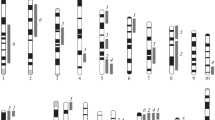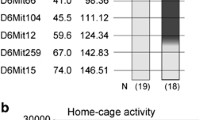Quantitative Trait Locus (QTL) analysis was used to identify the loci of polygenic characteristics in a study of the genetic determination of the behavior of rats with inherited stress-induced arterial hypertension (ISIAH rats). Analysis was performed using males of two populations of F2 hybrids (ISIAH × WAG) of different ages: 3–4 (n = 106) and six months (n = 130). Chromosomes 2 and 16 in the young population of F2 rats showed significant associations between two characteristics of behavior in ISIAH rats and genetic loci: a) the rats' motor activity at the periphery of the open field area with loci in the regions of markers D2Rat157-D2Rat88 (LOD score 4.83; p = 0.000058) and D16Rat32 (LOD score 3.71; p = 0.00023). Together, these two loci accounted for 42.9% of the trait variability; b) the rats' motor activity during the first minute of the open field test and loci in the region of the marker D16Rat58 (LOD score 3.78; p = 0.00028). Results obtained by QTL analysis demonstrated a relationship between the genetic control of these traits and the animals' age.
Similar content being viewed by others
References
A. L. Markel', “A genetic model of stress-induced arterial hypertension,” Izv. Akad. Nauk SSSR. Ser. Biol., 3, 466–469 (1985).
A. L. Markel', “Characteristics of the behavior of rats with inherited arterial hypertension,” Zh. Vyssh. Nerv. Deyat., 36, No. 5, 956–962 (1986).
A. L. Markel', K. Galaktionov, and V. M. Efimov, “Factor analysis of the behavior of rats in the open field test,” Zh. Vyssh. Nerv. Deyat., 38, No. 5, 855–863 (1988).
A. L. Markel' and R. A. Khusainov, “A method for the complex recording of behavioral and autonomic reactions in rats in the pen field test,” Zh. Vyssh. Nerv. Deyat., 26, No. 2, 1314–1318 (1976).
A. A. Tinnikov and N. M. Bazhan, “Estimation of plasma glucocorticoids in adrenal incubates by competitive binding of hormones with proteins without prior extraction,” Lab. Delo, 12, 709–713 (1984).
J. Archer, “Tests for emotionality in rats and mice: a review,” Anim. Behav., 21, No. 2, 205–235 (1973).
W. D. Beavis, “QTL analyses: power, precision and accuracy,” in: Molecular Analysis of Complex Traits, A. N. Paterson (ed.), CRC Press, Boca Raton (1988), pp. 123–150.
D. A. Blizard, C. T. Hansen, and L. S. Freedman, “Open-field behavior and the peripheral sympathetic nervous system in the MR/N and MNR/N rat strains,” Behav. Genet., 12, No. 4, 459–466 (1982).
E. S. Brodkin, “Quantitative trait locus analysis of aggressive behaviours in mice,” Novartis Found. Symp., 268, 57–69; discussion pp. 69–77 and 96–99 (2005).
M. F. Dallman, S. F. Akana, A. M. Strack, K. S. Scribner, N. Pecoraro, S. E. La Fleur, H. Houshyar, and F. Gomez, “Chronic stress-induced effects of corticosterone on brain: direct and indirect,” Ann. N.Y. Acad. Sci., 1018, 141–150 (2004).
R. K. Dishman, “Brain monoamines, exercise, and behavioral stress: animal models,” Med. Sci. Sports Exerc., 29, No. 1, 63–74 (1997).
N. Escobales and M. J. Crespo, “Oxidative-nitrosative stress in hypertension,” Curr. Vasc. Pharmacol., 3, No. 3, 231–246 (2005).
A. Fernandez-Teruel, R. M. Escorihuela, J. A. Gray, R. Aguilar, L. Gil, L. Gimenez-Llort, A. Tobena, A. Bhomra, A. Nicod, R. Mott, P. Driscoll, G. R. Fawson, and J. Flint, “A quantitative trait locus influencing anxiety in the laboratory rat,” Genome Res., 12, No. 4, 618–626 (2002).
P. Hamet, D. Malo, T. Hashimoto, and J. Tremblay, “Heat stress genes in hypertension,” J. Hypertens., 8, No. 7, Supplement, S47–S52 (1990).
E. D. Hendley and W. G. Ohlsson, “Two new inbred rat strains derived from SHR: WKHA, hyperactive, and WKHT, hypertensive, rats,” Amer. J. Physiol., 261, Part 2, H583–H589 (1991).
P. Kovacs, J. van den Brandt, and I. Kloting, “Effects of quantitative trait loci for lipid phenotypes in the rat are influenced by age,” Clin. Exp. Pharmacol. physiol., 25, No. 12, 1004–1007 (1998).
E. S. Lander, P. Green, J. Abrahamson, A. Barlow, M. J. Daly, S. E. Lincoln, and L. Newburg, “MAPMAKER: an interactive computer package for constructing primary genetic linkage maps of experimental and natural populations,” Genomics, 1, No. 2, 174–181 (1987).
J. H. Markovitz, B. S. Jonas, and K. Davidson, “Psychologic factors as precursors to hypertension,” Curr. Hypertens. Rep., 3, No. 1, 25–32 (2001).
P. McGuffin, B. Riley, and R. Plomin, “Genomics and behavior. Toward behavioral genomics,” Science, 291, No. 5507, 1232–1249 (2001).
M. P. Moisan, H. Courvoisier, M. T. Bihoreau, D. Gauguier, E. D. Hendley, M. Lathrop, M. R. James, and P. Mormede, “A major quantitative trait locus influences hyperactivity in the WKHA rat,” Nat. Genet., 14, No. 4, 471–473 (1996).
T. G. Pickering, “Mental stress as a causal factor in the development of hypertension and cardiovascular disease,” Curr. Hypertens. Rep., 3, No. 3, 249–254 (2001).
L. Prut and C. Belzung, “The open field as a paradigm to measure the effects of drugs on anxiety-like behaviors: a review,” Eur. J. Pharmacol., 463, No. 1–3, 3–33 (2003).
A. Ramos, M. P. Moisan, F. Chaouloff, C. Mormede, and P. Mormede, “Identification of female-specific QTLs affecting an emotionality-related behavior in rats,” Mol. Psychiatry, 4, No. 5, 453–462 (1999).
J. P. Rapp, “Genetic analysis of inherited hypertension in the rat,” Physiol. Rev., 80, No. 1, 135–172 (2000).
O. R. Redina, N. A. Machanova, V. M. Efimov, and A. L. Markel, “Rats with inherited stress-induced arterial hypertension (ISIAH strain) display specific quantitative trait loci for blood pressure and for body and kidney weight on chromosome 1,” Clin. Exp. Pharmacol. Physiol., 33, No. 5–6, 456–464 (2006).
T. Rutledge and B. E. Hogan, “A quantitative review of prospective evidence linking psychological factors with hypertension development,” Psychosom. Med., 64, No. 5, 758–766 (2002).
N. J. Samani, D. Gauguier, M. Vincent, M. A. Kaiser, M.-T. Bihoreau, D. Lodwick, R. Wallis, V. Parent, P. Kimber, F. Rattray, J. R. Thompson, J. Sassard, and M. Lathrop, “Analysis of quantitative trait loci for blood pressure on rat chromosomes 2 and 13: age-related differences in effect,” Hypertension, 28, No. 6, 1118–1122 (1996).
J. Sambrook, E. F. Fritsch, and T. Maniatis, Molecular Cloning: A Laboratory Manual, CSHL Press, Cold Spring Harbor (1989).
E. Terenina-Rigaldie, M. P. Moisan, A. Colas, E. Beauge, K. C. Shah, B. C. Jones, and P. Mormede, “Genetics of behaviour: phenotypic and molecular study of rats derived from high-and low-alcohol consuming lines, ” Pharmacogenetics, 13, No. 9, 543–554 (2003).
S. A. Willis-Owen and J. Flint, “The genetic basis of emotional behaviour in mice,” Eur. J. Hum. Genet., 14, No. 6, 721–728 (2006).
Author information
Authors and Affiliations
Corresponding author
Additional information
Translated from Zhurnal Vysshei Nervnoi Deyatel'nosti imeni I. P. Pavlova, Vol. 57, No. 6, pp. 692–701, November–December, 2007.
Rights and permissions
About this article
Cite this article
Redina, O.E., Smolenskaya, S.É., Maslova, L.N. et al. The characteristics of motor activity in ISIAH rats in an open field test are controlled by genes on chromosomes 2 and 16. Neurosci Behav Physi 39, 57–64 (2009). https://doi.org/10.1007/s11055-008-9100-8
Received:
Accepted:
Published:
Issue Date:
DOI: https://doi.org/10.1007/s11055-008-9100-8




